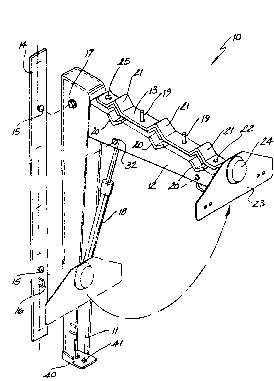Some of the information on this Web page has been provided by external sources. The Government of Canada is not responsible for the accuracy, reliability or currency of the information supplied by external sources. Users wishing to rely upon this information should consult directly with the source of the information. Content provided by external sources is not subject to official languages, privacy and accessibility requirements.
Any discrepancies in the text and image of the Claims and Abstract are due to differing posting times. Text of the Claims and Abstract are posted:
| (12) Patent Application: | (11) CA 2162873 |
|---|---|
| (54) English Title: | BICYLE RACK |
| (54) French Title: | SUPPORT POUR BICYCLETTE |
| Status: | Deemed Abandoned and Beyond the Period of Reinstatement - Pending Response to Notice of Disregarded Communication |
| (51) International Patent Classification (IPC): |
|
|---|---|
| (72) Inventors : |
|
| (73) Owners : |
|
| (71) Applicants : | |
| (74) Agent: | ROBIC AGENCE PI S.E.C./ROBIC IP AGENCY LP |
| (74) Associate agent: | |
| (45) Issued: | |
| (86) PCT Filing Date: | 1993-07-29 |
| (87) Open to Public Inspection: | 1994-12-08 |
| Availability of licence: | N/A |
| Dedicated to the Public: | N/A |
| (25) Language of filing: | English |
| Patent Cooperation Treaty (PCT): | Yes |
|---|---|
| (86) PCT Filing Number: | PCT/AU1993/000385 |
| (87) International Publication Number: | AU1993000385 |
| (85) National Entry: | 1995-11-14 |
| (30) Application Priority Data: | ||||||
|---|---|---|---|---|---|---|
|
A bicycle rack (10) may be supported by a base (40) on
a tow bar of a vehicle. The bicyle rack (10) includes an upright
post (11) having at its upper end a pivotally supported arm (12),
which is adapted by way of grooves (20) to support a number of
bicycles by engagement with the bicycle top tubes. To retain the
bicycles in place, a retaining plate (13) is held against the pivot
arm (12) by wing nuts applied to threaded fasteners (19) and a
padlock which may pass through a hole (22) and a corresponding
hole in the pivot arm (12). A gas strut (18) extends between the
post (11) and the pivot arm (12) to aid in its pivoting. A number
plate support (23) is pivotally attached to the remote end of the
pivot arm (12) and connected to the post (11) by a parallelogram
linkage to maintain the number plate in a generally vertical plane
regardless of the orientation of the pivot arm (12).
Porte-bicyclettes (10) pouvant être supporté par un socle (40) sur une barre de remorquage de véhicule. Le porte-bicyclettes (10) comprend un montant vertical (11) dont l'extrémité supérieure comporte un bras pivotant (12) qui est prévu pour supporter, grâce à des rainures (20), plusieurs bicyclettes qui sont bloquées par le tube horizontal. Pour retenir les bicyclettes en place, une plaque (13) de retenue est maintenue contre le bras de pivotement (12) par des écrous à oreilles vissés sur des fixations filetées (19) et par un cadenas qui peut traverser un trou (22) et un trou correspondant prévu dan le bras de pivotement (12). Un piston à gaz (18) s'étend entre le montant (11) et le bras de pivotement (12) pour faciliter son pivotement. Un support (23) pour plaque d'identification est fixé pivotant à l'extrémité éloignée du bras de pivotement (12) et relié au montant (11) par une articulation en parallélogramme pour maintenir la plaque d'identification dans un plan globalement vertical quelle que soit l'orientation du bras de pivotement.
Note: Claims are shown in the official language in which they were submitted.
Note: Descriptions are shown in the official language in which they were submitted.

2024-08-01:As part of the Next Generation Patents (NGP) transition, the Canadian Patents Database (CPD) now contains a more detailed Event History, which replicates the Event Log of our new back-office solution.
Please note that "Inactive:" events refers to events no longer in use in our new back-office solution.
For a clearer understanding of the status of the application/patent presented on this page, the site Disclaimer , as well as the definitions for Patent , Event History , Maintenance Fee and Payment History should be consulted.
| Description | Date |
|---|---|
| Inactive: IPC from MCD | 2006-03-12 |
| Time Limit for Reversal Expired | 1999-07-29 |
| Application Not Reinstated by Deadline | 1999-07-29 |
| Deemed Abandoned - Failure to Respond to Maintenance Fee Notice | 1998-07-29 |
| Application Published (Open to Public Inspection) | 1994-12-08 |
| Abandonment Date | Reason | Reinstatement Date |
|---|---|---|
| 1998-07-29 |
The last payment was received on 1997-07-10
Note : If the full payment has not been received on or before the date indicated, a further fee may be required which may be one of the following
Patent fees are adjusted on the 1st of January every year. The amounts above are the current amounts if received by December 31 of the current year.
Please refer to the CIPO
Patent Fees
web page to see all current fee amounts.
| Fee Type | Anniversary Year | Due Date | Paid Date |
|---|---|---|---|
| MF (application, 4th anniv.) - small | 04 | 1997-07-29 | 1997-07-10 |
Note: Records showing the ownership history in alphabetical order.
| Current Owners on Record |
|---|
| KEN JOHN BRYAN |
| Past Owners on Record |
|---|
| None |